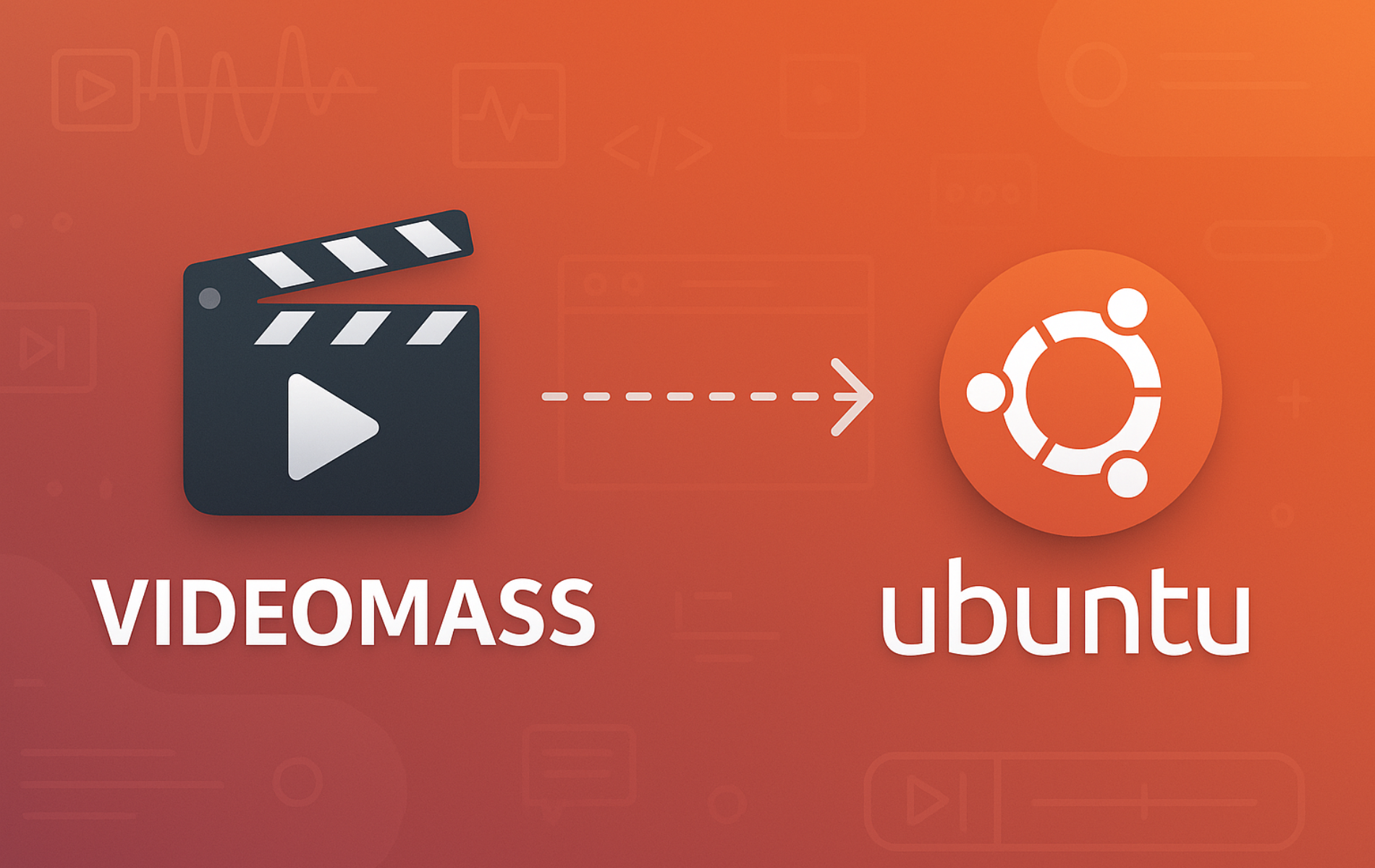Videomass offers a graphical interface for FFmpeg and yt-dlp, eliminating the need to memorize complex command-line syntax. If you have struggled with FFmpeg’s options or wanted batch conversion without scripting, this tool bridges the gap between power and usability. You will set up the official PPA, install version 6.1.20, and configure the application for immediate use (completing format conversions, YouTube downloads, and audio extraction through a desktop GUI).
This approach solves three common pain points: navigating FFmpeg’s hundreds of codec options, batch-processing files without custom scripts, and monitoring conversion progress visually. By the end you will have installed Videomass on Ubuntu 24.04 or 22.04 LTS, configured FFmpeg detection, and run your first conversion (whether you are archiving recordings, preparing video for mobile playback, or extracting audio from conference talks).
Update Package Lists Before Installation
Before adding third-party repositories or installing new software, update your package lists to ensure APT has the latest package metadata from configured sources. This prevents version conflicts and ensures dependencies resolve correctly during Videomass installation:
sudo apt update && sudo apt upgradeThe update command refreshes package lists, while upgrade installs newer versions of currently installed packages. Running both commands together ensures your system has the latest security patches and library versions before adding the Videomass PPA.
Add Videomass PPA Repository
Videomass is not available in Ubuntu’s default repositories, so you need to add a Personal Package Archive (PPA) maintained by the Videomass developer. PPAs function like third-party software sources that integrate with APT, Ubuntu’s package manager. Think of them as adding a new software vendor to your system, similar to how Windows lets you install programs from sources beyond the Microsoft Store.
The official Videomass PPA provides the latest stable releases and receives updates directly from the maintainer. Once added, Videomass updates automatically through your regular apt upgrade cycle alongside other system packages:
sudo add-apt-repository ppa:jeanslack/videomass -yAfter adding the PPA, refresh your package lists so APT recognizes the new repository and its available packages:
sudo apt updateInstall Videomass Package
With the PPA configured, install Videomass using APT. The package includes all required Python dependencies and desktop integration files for launching the application from your applications menu:
sudo apt install videomass -yAPT installs Videomass along with FFmpeg (if not already present), wxPython GUI libraries, and Python modules for handling media processing tasks. The installation creates a /usr/bin/videomass executable and registers the application with your desktop environment.
Verify the installation by checking the installed version:
videomass --versionThe output confirms Videomass version 6.1.20 is installed and ready to use:
Videomass: 6.1.20 (released) Platform: Linux Python: 3.12.3 wxPython: 4.2.1
Launch Videomass Application
Start Videomass using either the command line or your desktop environment’s graphical applications menu. Terminal launch is useful for viewing diagnostic messages during troubleshooting, while the applications menu provides standard desktop integration.
Launch from Terminal
Run Videomass directly from the terminal. This method displays any error messages or warnings in your terminal window, which helps diagnose configuration issues:
videomassLaunch from Applications Menu
Most users prefer launching Videomass through the desktop applications menu. The installation registers Videomass with your desktop environment, so it appears alongside other installed applications. On GNOME (Ubuntu’s default desktop):
- Click Activities in the top-left corner or press the Super key
- Click Show Applications (the grid icon at the bottom of the dock)
- Type “Videomass” or scroll to find the VideoMass icon
- Click the icon to launch the application
Other desktop environments (KDE, XFCE, MATE) have similar application launchers—look for the applications menu or search function in your desktop’s panel.
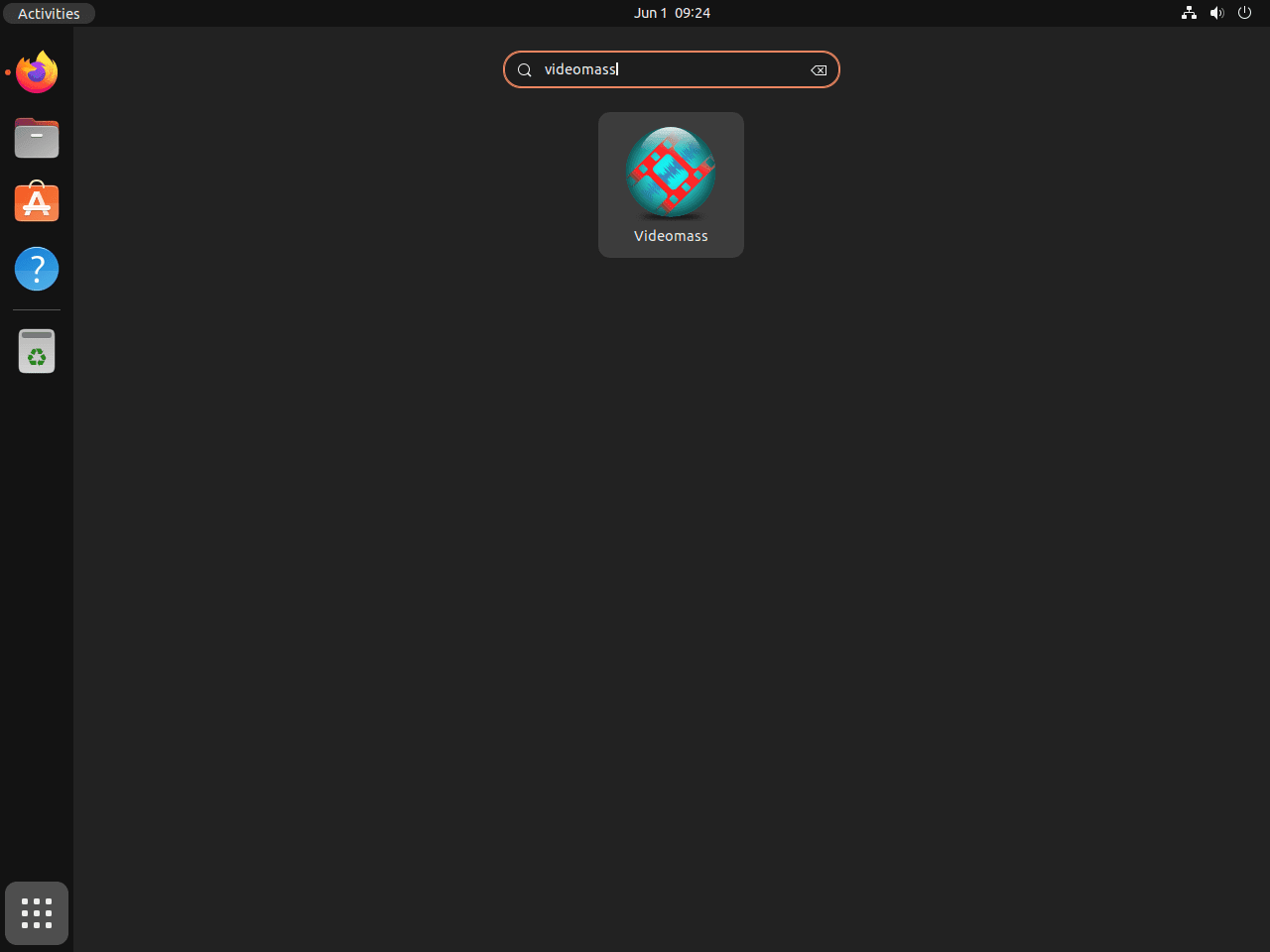
Complete First-Run Setup Wizard
When you launch Videomass for the first time, a setup wizard guides you through locating required tools and configuring optional features. This one-time configuration ensures Videomass can find FFmpeg for video processing and optionally enables yt-dlp for downloading online videos. The wizard takes about one minute to complete and saves your preferences for future sessions.
Start Configuration Wizard
The setup wizard opens automatically on first launch with a welcome screen explaining the configuration process. Click Next to begin:
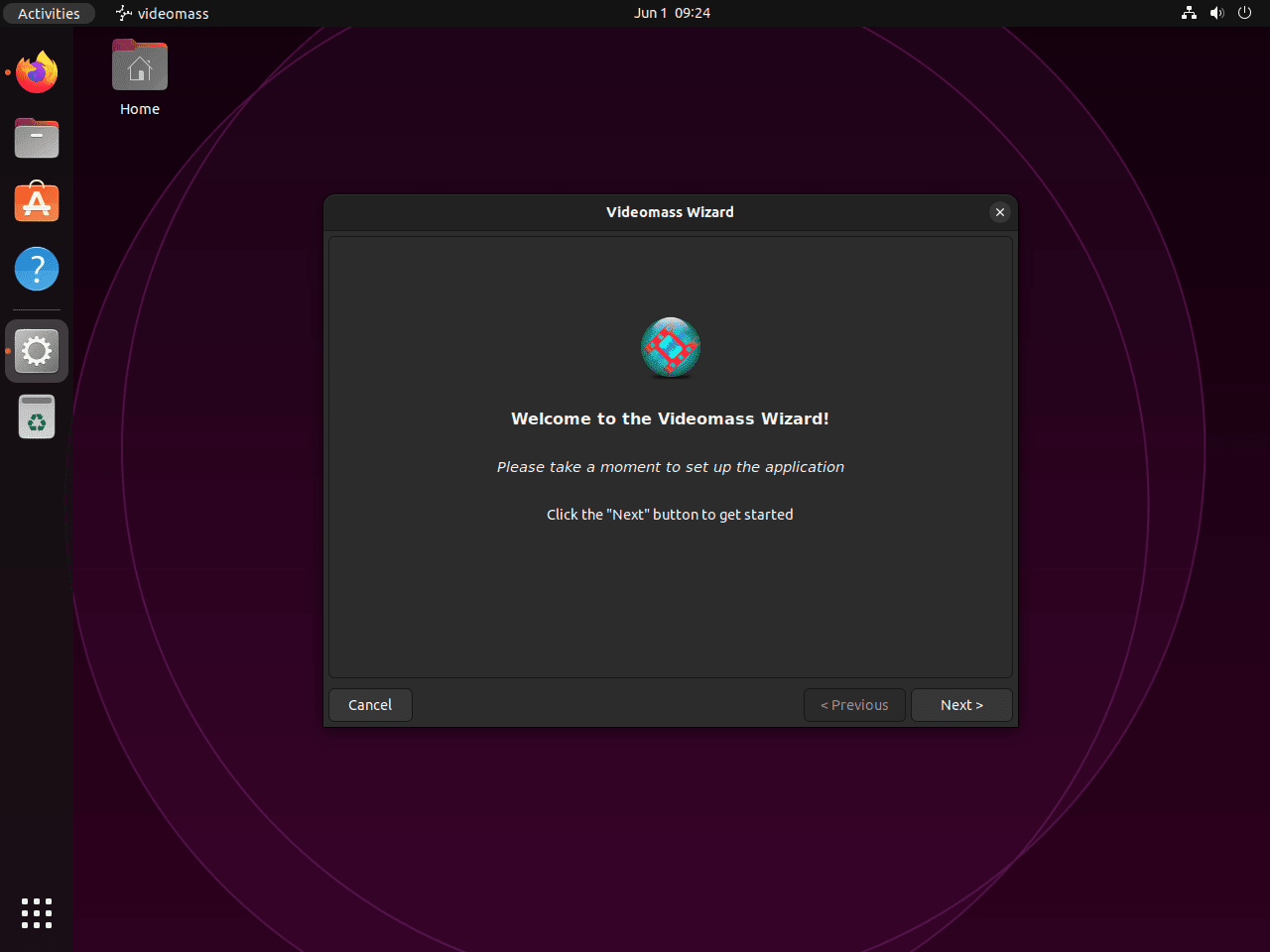
Configure FFmpeg Location
Videomass acts as a graphical frontend for FFmpeg, the command-line tool that performs the actual video and audio conversion work. The setup wizard needs to locate your FFmpeg installation to generate proper conversion commands. On Ubuntu systems with FFmpeg installed through APT, the auto-detection option works reliably—Videomass searches standard installation paths like /usr/bin/ffmpeg and /usr/local/bin/ffmpeg.
Select Auto-detection and click Next. Manual path specification is only necessary if you compiled FFmpeg from source into a non-standard directory or maintain multiple FFmpeg versions for testing purposes.
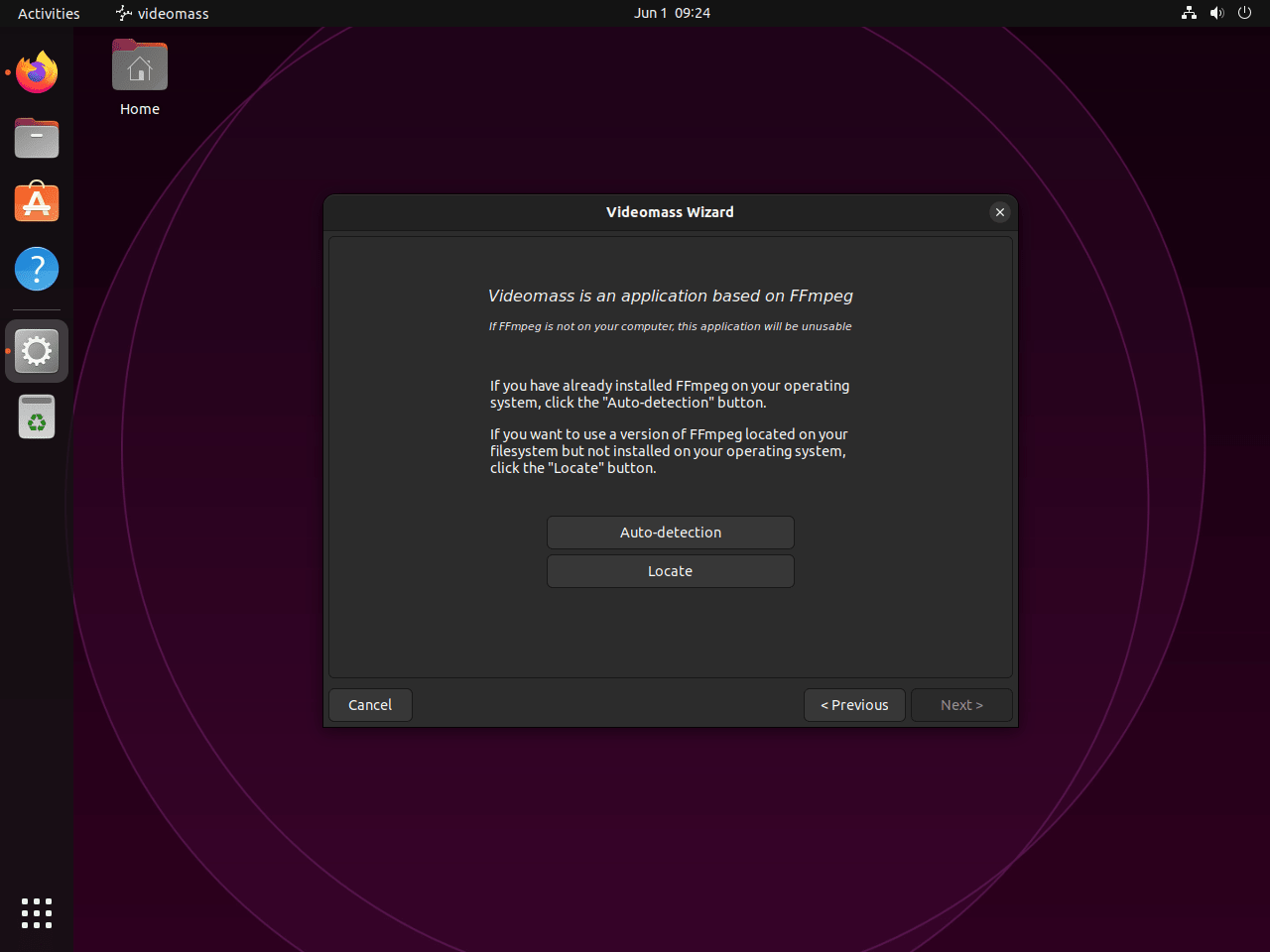
If the wizard reports FFmpeg is missing, install it from Ubuntu’s default repositories before continuing the setup. FFmpeg is a core dependency. Videomass cannot process media files without it.
sudo apt install ffmpeg -yAfter verifying FFmpeg is detected, click Next to continue. If you work with other multimedia tools that use FFmpeg, consider checking VLC Media Player on Ubuntu for playback testing or OBS Studio on Ubuntu for screen recording workflows.
Configure yt-dlp for Online Video Downloads
The wizard offers optional yt-dlp integration, which extends Videomass with the ability to download videos directly from YouTube, Vimeo, and hundreds of other streaming sites. If you plan to download online videos for offline conversion or archival purposes, enable this feature. If you only need Videomass for converting local files, you can skip yt-dlp configuration.
Select your preference and click Next to proceed:

Finish Setup and Access Main Interface
The wizard displays a summary of your configuration choices on the final screen. Videomass saves these preferences in your home directory (~/.config/videomass/), so you will not need to repeat this setup on subsequent launches. Click Finish to close the wizard and access the main Videomass interface:

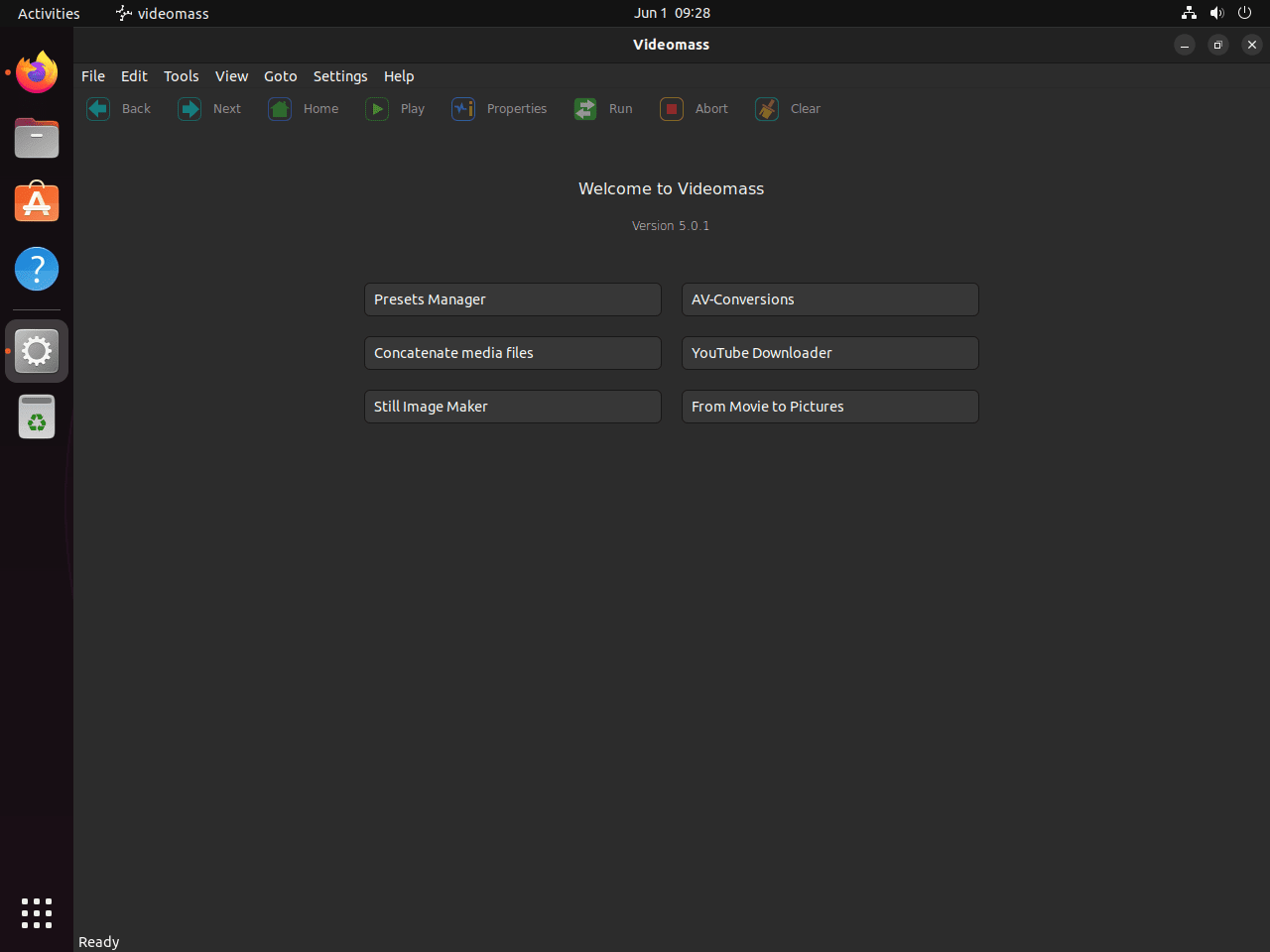
Update Videomass to Latest Version
The PPA installation method ensures Videomass updates automatically through your regular system upgrade cycle. When the Videomass maintainer publishes a new release to the PPA, it appears alongside other package updates during your standard apt upgrade process.
Update Videomass along with all other system packages:
sudo apt update && sudo apt upgradeFor targeted updates that upgrade only Videomass without touching other packages:
sudo apt install --only-upgrade videomassVerify the updated version after upgrade completes:
videomass --versionThe output confirms the current installed version:
Videomass: 6.1.20 (released) Platform: Linux Python: 3.12.3 wxPython: 4.2.1
Troubleshoot Common Videomass Issues
Most Videomass problems stem from missing dependencies, incorrect FFmpeg paths, or format compatibility issues. The following solutions address the most frequently encountered issues reported by Ubuntu users.
FFmpeg Not Detected After Installation
If Videomass reports it cannot find FFmpeg despite successful installation, verify FFmpeg is accessible in your system PATH. Run this diagnostic command:
which ffmpegExpected output showing FFmpeg location:
/usr/bin/ffmpeg
If which returns no output, FFmpeg is not installed or not in your PATH. Install or reinstall FFmpeg:
sudo apt install --reinstall ffmpegAfter reinstalling, launch Videomass from the terminal to see diagnostic messages. If Videomass still cannot locate FFmpeg, open the setup wizard again (Tools → Setup) and manually specify /usr/bin/ffmpeg as the FFmpeg path.
yt-dlp Download Failures
Online video downloads may fail due to outdated yt-dlp versions. Streaming sites frequently change their APIs, requiring yt-dlp updates to maintain compatibility. If downloads fail with “Unable to extract video data” or similar errors, update yt-dlp to the latest version:
sudo apt update && sudo apt install --only-upgrade yt-dlpAlternatively, install yt-dlp via pip for more frequent updates (the pip version updates more often than the Ubuntu package):
pip3 install --upgrade yt-dlpAfter updating, restart Videomass and retry the download. Check the Videomass log window (View → Show Logs) for detailed error messages if downloads continue failing.
Conversion Errors with Specific Formats
Some video formats require specific FFmpeg codec libraries that may not be included in Ubuntu’s default FFmpeg build. If conversions fail with “Unknown encoder” or “Codec not found” errors, verify your FFmpeg installation includes the required codecs:
ffmpeg -codecs | grep -i [codec-name]For example, to check for H.265/HEVC support:
ffmpeg -codecs | grep -i hevcExpected output showing HEVC codec support:
DEV.L. hevc H.265 / HEVC (High Efficiency Video Coding)
If the codec is missing, install additional FFmpeg codec packages or consider using alternative output formats supported by your FFmpeg build. Common workarounds include converting to H.264 (universally supported) instead of H.265, or using VP9 for WebM containers.
Remove Videomass and PPA Repository
If you no longer need Videomass, remove the package and optionally clean up the PPA repository to keep your system’s software sources tidy. Removing the package uninstalls Videomass and its desktop integration but preserves FFmpeg and other shared dependencies used by other applications.
Uninstall the Videomass package:
sudo apt remove videomass -yRemove orphaned dependencies that were installed alongside Videomass but are no longer needed by any installed packages:
sudo apt autoremove -yRemove the Videomass PPA from your system’s software sources. This prevents APT from checking the PPA during future apt update operations:
sudo add-apt-repository --remove ppa:jeanslack/videomass -yRefresh package lists to confirm the PPA removal and verify Videomass is no longer available:
sudo apt updateapt-cache policy videomassModern APT returns empty output when a package is not available, confirming complete removal. If you want to remove Videomass configuration files stored in your home directory, delete the settings directory:
rm -rf ~/.config/videomassConclusion
You now have Videomass installed via PPA with automatic updates, FFmpeg configured for media processing, and optional yt-dlp integration for downloading online videos. The graphical interface eliminates command-line complexity for batch conversions, format changes, and codec troubleshooting. For complementary workflows, VLC Media Player on Ubuntu handles playback testing, MPV Player on Ubuntu provides codec inspection, and OBS Studio on Ubuntu covers screen recording needs.

